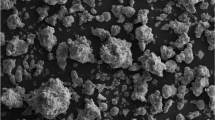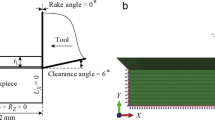Abstract
The most important consequence of adiabatic shear phenomenon is formation of sawtooth chip. Lots of scholars focused on the formation mechanism of sawtooth, and the research often depended on experimental approach. For the present, the mechanism of sawtooth chip formation still remains some ambiguous aspects. This study develops a combined numerical and experimental approach to get deeper understanding of sawtooth chip formation mechanism for Polycrystalline Cubic Boron Nitride (PCBN) tools orthogonal cutting hard steel GCr15. By adopting the Johnson-Cook material constitutive equations, the FEM simulation model established in this research effectively overcomes serious element distortions and cell singularity in high strain domain caused by large material deformation, and the adiabatic shear phenomenon is simulated successfully. Both the formation mechanism and process of sawtooth are simulated. Also, the change features regarding the cutting force as well as its effects on temperature are studied. More specifically, the contact of sawtooth formation frequency with cutting force fluctuation frequency is established. The cutting force and effect of cutting temperature on mechanism of adiabatic shear are investigated. Furthermore, the effects of the cutting condition on sawtooth chip formation are researched. The researching results show that cutting feed has the most important effect on sawtooth chip formation compared with cutting depth and speed. This research contributes a better understanding of mechanism, feature of chip formation in hard turning process, and supplies theoretical basis for the optimization of hard cutting process parameters.
Similar content being viewed by others
References
DODDB, BAI Y. Adiabatic shear localization, second edition: Frontiers and Advances[M]. Burlington, 2012.
DAFERMOS C M, HSIAO L. Adiabatic shearing of incompressible fluids with temperature-dependent viscosity[J]. Quarterly of Applied Mathematics, 1983, 41: 45–58.
ROGERS H C. Adiabatic shearing-general nature and material aspects[M]//Material Behavior Under High Stress and Ultrahigh Loading Rates. Springer US, 1983: 101–118.
CERETTI E, LUCCHI M, ALTAN T. FEM simulation of orthogonal cutting: serrated chip formation[J]. Journal of Materials Processing Technology, 1999, 95(1): 17–26.
CHRISTIAN H, SVENDSEN B. Simulation of chip formation during high speed cutting[J]. Journal of Materials Processing Technology, 2007, 186: 66–76.
CERETTI E, FALLBÖHMER P, WU W T, et al. Application of 2D FEM to chip formation in orthogonal cutting[J]. Journal of Materials Processing Technology, 1996, 59(1): 169–180.
CERETTI E, LAZZARONI C, MENEGARDO L, et al. Turning simulations using a three-dimensional FEM code[J]. Journal of Materials Processing Technology, 2000, 98(1): 99–103.
LIN Z C, LO S P. 2-D discontinuous chip cutting model by using strain energy density theory and elastic-plastic finite element method[J]. International Journal of Mechanical Sciences, 2001, 43(2): 381–398.
LIN Z C, HUANG J C. A nano-orthogonal cutting model based on a modified molecular dynamics technique[J]. Nanotechnology, 2004, 15(5): 510.
LIN Z C, HUANG J C, JENGY R. 3D nano-scale cutting model for nickel material[J]. Journal of Materials Processing Technology, 2007, 192: 27–36.
MATSUMURA T, USUI E. Simulation of cutting process in peripheral milling by predictive cutting force model based on minimum cutting energy[J]. International Journal of Machine Tools and Manufacture, 2010, 50(5): 467–473.
NG E G, ASPINWALL D K. Modelling of hard part machining[J]. Journal of Materials Processing Technology, 2002, 127(2): 222–229.
RATCHEV S M, AFAZOV S M, BECKER A A, et al. Mathematical modelling and integration of micro-scale residual stresses into axisymmetric FE models of Ti6Al4V alloy in turning[J]. CIRP Journal of Manufacturing Science and Technology, 2011, 4(1): 80–89.
RATCHEV S M. Concurrent process and facility prototyping for formation of virtual manufacturing cells[J]. Integrated Manufacturing Systems, 2001, 12(4): 306–315.
PANTALÉ O, BACARIA J L, DALVERNY O, et al. 2D and 3D numerical models of metal cutting with damage effects[J]. Computer methods in applied mechanics and engineering, 2004, 193(39): 4383–4399.
AFAZOV S M, RATCHEV S M, SEGAL J, et al. Chatter modelling in micro-milling by considering process nonlinearities[J]. International Journal of Machine Tools and Manufacture, 2012, 56: 28–38.
YE G G, XUE S F, JIANG M Q, et al. Modeling periodic adiabatic shear band evolution during high speed machining Ti-6Al-4V alloy[J]. International Journal of Plasticity, 2013, 40: 39–55.
SIMA. Mohammad, OZEL Tugrul. Modified material constitutive models for serrated chip formation simulations and experimental validation in machining of titanium alloy Ti–6Al–4V[J]. International Journal of Machine Tools & Manufacture, 2010, 50: 943–960.
MOLINARI A, MUSQUARC, SUTTERG. Adiabatic shear banding in high speed machining of Ti–6Al–4 V: experiments and modeling[J]. International Journal of Plasticity, 2002, 18: 443–459.
JOHNSON G R, COOK W H. Fracture characteristics of three metals subjected to various strains, strain rates, temperatures and pressures[J]. Engineering Fracture Mechanics, 1985, 21(1): 31–48.
GUO Y B, WEN Q, WOODBURY K A. Dynamic material behavior modeling using internal state variable plasticity and its application in hard machining simulations[J]. Journal of Manufacturing Science and Engineering, 2006, 128(3): 749–759.
Author information
Authors and Affiliations
Corresponding author
Additional information
Supported by National Natural Science Foundation of China (Grant Nos. 51105119, 51235003)
YUE Caixu, born in 1982, associate professor. He received his doctor degree on machinery manufacture from Harbin University of Science and Technology, China, in 2013. His research interests include hard cutting mechanics and control of cutting process.
WANG Bo, born in 1964. She is a PhD candidate at Harbin University of Science and Technology, China. Her research interest includes cutting mechanics of free-form surfaces.
LIU Xianli, born in 1961, a PhD supervisor, is a professor at Harbin University of Science and Technology, China. He received his doctor degree on machinery manufacture from Harbin Institute of Technology, China, in 1999.
FENG Huize, born in 1985. He is a master candidate at Harbin University of Science and Technology, China. His research interest is hard cutting mechanics of free-form surfaces.
CAI Chunbin, born in 1989. He is a master candidate at Harbin University of Science and Technology, China. His research interest is finite element simulation technology of hard cutting process.
Rights and permissions
About this article
Cite this article
Yue, C., Wang, B., Liu, X. et al. Adiabatic shear mechanisms for the hard cutting process. Chin. J. Mech. Eng. 28, 592–598 (2015). https://doi.org/10.3901/CJME.2015.0311.028
Received:
Revised:
Accepted:
Published:
Issue Date:
DOI: https://doi.org/10.3901/CJME.2015.0311.028




